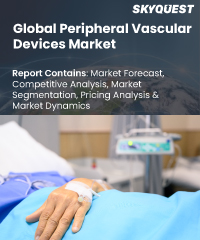
Report ID: SQMIG35A2529

Report ID:
SQMIG35A2529 |
Region:
Global |
Published Date: April, 2024
Pages:
219
|
Tables:
94 |
Figures:
76
Peripheral Vascular Devices Market size was valued at USD 11.45 Billion in 2023 and is poised to grow from USD 12.07 Billion in 2024 to USD 18.37 Billion by 2032, growing at a CAGR of 5.4% during the forecast period (2025-2032).
Global Peripheral Vascular Devices Market is a dynamic and rapidly growing sector that encompasses the development, manufacturing, and distribution of medical devices used in the diagnosis and treatment of peripheral vascular diseases. With a rising prevalence of vascular diseases and aging population, the demand for innovative and effective peripheral vascular devices is increasing worldwide. The purpose of the peripheral vascular devices market is to provide medical professionals with advanced tools and technologies to diagnose and treat vascular conditions. These devices enable minimally invasive procedures, such as angioplasty, stenting, atherectomy, and thrombectomy, which offer quicker recovery times, reduced complications, and improved patient comfort. They help restore blood flow, alleviate pain, and prevent complications associated with vascular diseases.
The increasing prevalence of lifestyle-related diseases, such as diabetes, obesity, and hypertension, contributes to the rising incidence of vascular conditions, driving the demand for effective treatment options. Furthermore, technological advancements in imaging techniques, such as ultrasound and angiography, enhance the accuracy of diagnosis and guide interventions, fostering the adoption of peripheral vascular devices. Moreover, favorable reimbursement policies and growing awareness among healthcare providers and patients further fuel market growth. However, stringent regulatory requirements and approval processes can pose challenges for device manufacturers, leading to longer timeframes and higher costs for bringing new products to market. Additionally, the high cost of advanced peripheral vascular devices may limit their accessibility, particularly in emerging economies. Furthermore, the lack of skilled healthcare professionals proficient in performing complex procedures using these devices can hinder the market growth. Key trends shaping the peripheral vascular devices market include the development of drug-coated balloons, bioresorbable stents, and other innovative technologies that enhance the efficacy and long-term outcomes of vascular interventions. The market is also witnessing a shift towards personalized medicine, where devices are tailored to individual patient needs, optimizing treatment outcomes. Moreover, the integration of digital health technologies, such as remote monitoring and telemedicine, holds immense potential in improving patient care and treatment adherence.
US Peripheral Vascular Devices Market is poised to grow at a sustainable CAGR for the next forecast year.
Our industry expert will work with you to provide you with customized data in a short amount of time.
REQUEST FREE CUSTOMIZATIONWant to customize this report? This report can be personalized according to your needs. Our analysts and industry experts will work directly with you to understand your requirements and provide you with customized data in a short amount of time. We offer $1000 worth of FREE customization at the time of purchase.

Report ID: SQMIG35A2529